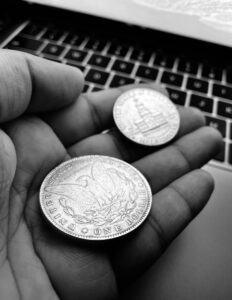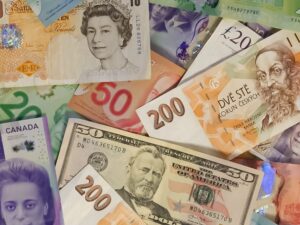From gross domestic product (GDP) to consumer spending, employment rates to housing market trends – we’re covering it all! So sit back, relax, and get ready for a deep dive into this captivating topic. Let’s uncover why the U.S. economy is experiencing its slowest pace in nearly a year and discover how various factors have contributed to this intriguing situation. It’s time to unravel some economic mysteries!
Gross domestic product (GDP)
Gross domestic product (GDP) is a crucial indicator of the overall economic health and performance of a country. In simple terms, it measures the total value of all goods and services produced within a specific time frame, typically a year. It’s like taking the pulse of an economy – telling us whether it’s booming or struggling.
The latest data reveals that the U.S. GDP growth rate has hit its slowest pace in nearly a year, sparking curiosity among economists and analysts alike. This slowdown can be attributed to various factors at play in recent times.
One significant factor is undoubtedly the ongoing impact of the coronavirus pandemic. The global health crisis disrupted supply chains, forced businesses to shut down temporarily or permanently, and created uncertainty among consumers who held back on spending.
Another contributing factor has been trade tensions between the United States and China. These two economic giants have been engaged in tariff wars, imposing import duties on each other’s products. Such actions not only disrupt international trade but also affect business confidence and investment decisions.
The Federal Reserve plays a vital role in influencing economic growth through its monetary policies. By adjusting interest rates, controlling inflation levels, and implementing stimulus measures when necessary, they aim to maintain stability within the economy as well as stimulate growth.
Consumer spending patterns are another key aspect affecting GDP growth rates. With businesses closed or operating under restricted conditions due to lockdowns during the pandemic, consumer confidence declined significantly. As people tightened their belts amidst uncertain times, their reduced spending had an impact on overall economic output.
Businesses’ level of investment also affects GDP growth rates since it reflects their optimism about future prospects for profitability and expansion opportunities. During periods of uncertainty like we’ve experienced recently with COVID-19 disruptions and trade tensions, companies may hold back on capital expenditures until there is more clarity surrounding market conditions.
Government spending can act as both a stabilizing force during downturns or an additional boost during times of recession by injecting funds into the economy through public projects, infrastructure development, and social welfare programs.
Economic growth
Economic growth is a key indicator of the overall health and prosperity of a nation’s economy. It reflects the increase in the production and consumption of goods and services over a specific period. In recent times, however, the U.S. economy has experienced a slowdown in its growth rate.
This deceleration can be attributed to various factors, one being the lingering effects of the coronavirus pandemic. The outbreak resulted in widespread disruptions across industries, leading to reduced consumer spending and business investment.
Additionally, trade tensions between the U.S. and China have further contributed to this sluggish economic growth. Tariffs imposed on various goods have dampened international trade flows, impacting both countries’ economies negatively.

The Federal Reserve’s monetary policies also play a significant role here. Interest rate hikes or cuts influence borrowing costs for businesses and individuals alike, affecting their willingness to spend or invest.
Furthermore, consumer spending patterns have changed due to uncertainties surrounding job security and income stability. This cautious approach has led to decreased demand for products and services throughout different sectors.
Moreover, business investment has been subdued as companies prioritize cost-cutting measures amidst uncertain market conditions. This lack of capital expenditure limits productivity gains that could stimulate economic expansion.
Government spending is another factor influencing economic growth rates. Fiscal policies that promote infrastructure development or support social welfare programs can boost economic activity by creating jobs and increasing public consumption.
The housing market also plays an essential part in driving economic growth as it impacts construction activity, employment rates, and household wealth accumulation through property appreciation.
Lastly but importantly, employment levels are closely tied to overall economic performance since they determine consumers’ purchasing power while indicating business confidence levels regarding future prospects.
The U.S. economy
The U.S. economy is a powerhouse that drives global markets and sets the tone for economic growth worldwide. It is constantly evolving, shaped by various factors such as policy decisions, market trends, and external forces.
One key factor influencing the U.S. economy in recent times has been the impact of the coronavirus pandemic. The outbreak forced businesses to shut down temporarily, leading to job losses and a slowdown in economic activity. However, efforts were made to mitigate the effects through stimulus packages and monetary policies from the Federal Reserve.
Another significant element affecting the U.S. economy is trade tensions with China. The ongoing trade war between these two major economies has resulted in increased tariffs on goods, disrupting supply chains and causing uncertainty among businesses.

Consumer spending plays a vital role in driving economic growth in America. When consumers have confidence and disposable income, they tend to spend more on goods and services, boosting overall demand.
Business investment also contributes significantly to economic expansion. When companies invest in new equipment or expand their operations, it creates jobs and stimulates productivity.
Government spending can play an important role during times of recession by providing fiscal stimulus through infrastructure projects or social programs.
The housing market is another crucial indicator of economic health as it reflects consumer sentiment towards making long-term investments.
Employment levels are a fundamental measure of how well an economy is performing. Low unemployment rates indicate a robust labor market with ample opportunities for individuals seeking work.
In conclusion, the U.S. economy is influenced by multiple factors including consumer spending patterns,
business investment levels, government policies, and international trade dynamics.
Despite challenges like the coronavirus pandemic and trade tensions with China, the resilience of this vast economy remains evident.
Understanding these various elements helps us gauge its current state and anticipate future trends that will shape our financial landscape
The impact of the coronavirus pandemic
The impact of the coronavirus pandemic has been unprecedented, affecting almost every aspect of our lives. From health concerns to economic turmoil, this global crisis has left a lasting mark on societies around the world.
One of the most significant effects of the pandemic has been on businesses and industries. Many have faced closures or severe disruptions in operations, leading to job losses and financial hardship for millions of people. Small businesses, in particular, have been hit hard as they struggle to navigate through these uncertain times.
The travel and tourism industry has taken a massive blow due to travel restrictions and fear among travelers. Hotels, airlines, restaurants, and other related sectors are grappling with decreased demand and revenue loss. The ripple effect is felt across various supply chains – from local vendors supplying goods to hotels to international exporters relying on tourist spending.
Additionally, consumer behavior has drastically changed during this time. With social distancing measures in place and people prioritizing essential purchases over luxury items or non-essential services such as dining out or entertainment venues; retail sales have suffered significantly.
Financial markets have experienced extreme volatility since the onset of the pandemic. Investors are constantly monitoring news related to vaccine developments or government stimulus packages that could potentially stabilize economies worldwide.
Furthermore, healthcare systems have been strained beyond capacity trying to cope with rising cases while also providing care for other medical needs unrelated to COVID-19. Hospitals face challenges such as resource allocation shortages like ventilators or personal protective equipment (PPE), putting immense pressure on healthcare workers who risk their lives daily fighting this virus.
It is clear that the impact of the coronavirus pandemic will be long-lasting even after vaccines become widely available. It will take time for economies around the world to recover fully from this crisis, but resilience and adaptation will play key roles in shaping our future post-pandemic society
Trade tensions between the US. and China
Trade tensions between the U.S. and China have been a significant factor impacting the growth of the U.S. economy in recent years. These two global economic powerhouses have engaged in tit-for-tat tariffs, imposing import taxes on each other’s goods, creating an environment of uncertainty and instability.
The trade dispute between these nations has had far-reaching consequences across various sectors. American businesses that rely heavily on Chinese imports have faced increased costs due to higher tariffs, leading to reduced profit margins or passing those costs onto consumers.
Conversely, Chinese exporters have also felt the impact of this trade war, as their products face barriers to entry into the lucrative U.S. market. This has resulted in decreased demand for Chinese goods and put pressure on their economy.
Moreover, this ongoing conflict has disrupted global supply chains and affected multinational companies operating in both countries. Uncertainty surrounding future trade relations makes it difficult for businesses to plan investments and make long-term strategic decisions.
While there have been attempts at negotiations and temporary truces between the U.S. and China, a comprehensive resolution remains elusive. As a result, businesses continue to navigate uncertain terrain marked by shifting regulations and potential retaliatory actions from both sides.
It is clear that trade tensions between the U.S. and China are not only affecting bilateral relations but also reverberating throughout the global economy. The impact on consumer confidence, business investment decisions, job creation, and overall economic growth cannot be understated. Finding common ground through dialogue rather than escalating hostilities is crucial for fostering stable international trade relationships that can benefit all parties involved.
The Federal Reserve
The Federal Reserve, often referred to as the Fed, is the central bank of the United States. It plays a crucial role in shaping and managing the country’s monetary policy. As an independent entity, its primary objective is to maintain stable prices and maximize employment.
One of the key tools that the Fed uses to achieve these goals is interest rate adjustments. By raising or lowering interest rates, it can influence borrowing costs for consumers and businesses alike. When economic growth slows down, the Fed may lower interest rates to stimulate spending and investment. Conversely, when inflation starts creeping up too quickly, they might raise rates to cool down excessive price increases.
Another important function of the Federal Reserve is regulating banks and financial institutions. It supervises their activities to ensure they operate safely and comply with relevant regulations. This oversight helps protect consumers from unfair practices and promotes stability within the financial system.
In times of crisis or severe economic downturns, such as during the 2008 global financial crisis or more recently due to COVID-19 pandemic repercussions on markets worldwide ,the Federal Reserve has taken extraordinary measures including implementing various stimulus programs like quantitative easing (QE) which involves purchasing large amounts of government bonds or other securities from banks in order increase liquidity in financial markets
Overall,the Federal Reserve plays a crucial role in maintaining a healthy economy by carefully monitoring market conditions, adjusting interest rates accordingly,and implementing necessary measures when faced with challenges like recessions or crises
Consumer spending
Consumer spending plays a crucial role in driving economic growth and shaping the overall health of the U.S. economy. After all, when consumers open their wallets and spend on goods and services, it stimulates demand, creates jobs, and fuels business expansion.
The impact of the coronavirus pandemic has undoubtedly affected consumer spending patterns. With lockdowns imposed and businesses shuttered temporarily, many individuals have faced financial uncertainties or reduced incomes. Naturally, this has led to cautious spending habits as people prioritize essential necessities over non-essential purchases.

However, recent data suggests that consumer spending is gradually rebounding as restrictions ease and vaccination rates increase. As more Americans regain confidence in their financial stability and return to pre-pandemic levels of income, they are likely to loosen their purse strings once again.
It’s worth noting that pent-up demand may also contribute to a surge in consumer spending. Many individuals have been saving money during the pandemic due to limited opportunities for entertainment or travel. As restrictions lift further, we can expect some of these savings to be unleashed into various sectors of the economy.
Nevertheless, certain factors could still influence consumer behavior moving forward. Ongoing concerns about job security or potential future waves of infections could continue to weigh on discretionary spending decisions.
In conclusion (not conclusive), while consumer spending remains an essential driver for economic growth in the U.S., its trajectory will depend on several variables such as vaccine distribution efforts, employment conditions improving steadily across industries, and people regaining confidence in their personal finances post-pandemic. Nonetheless (nevertheless), keeping an eye on consumer sentiment will provide valuable insights into how this vital aspect shapes our economic recovery journey.
Business investment
Business investment plays a crucial role in the growth and development of any economy. It is a key indicator of economic health, as it reflects businesses’ confidence in the future prospects of the market. In the case of the U.S. economy, business investment has experienced its fair share of ups and downs over recent years.
The impact of the coronavirus pandemic has undoubtedly affected business investment across various sectors. With uncertainty looming large, many businesses have been cautious about making long-term investments. The fear of potential lockdowns, supply chain disruptions, and changing consumer behavior has led to a more conservative approach.
Trade tensions between the U.S. and China have also played a significant role in shaping business investment decisions. Tariffs imposed on certain goods have disrupted global supply chains, prompting some companies to reconsider their manufacturing strategies or seek alternative markets for sourcing materials.
Additionally, monetary policy set by the Federal Reserve can influence business investment decisions through interest rates and credit availability. Lower interest rates incentivize borrowing for investments while tighter credit conditions may discourage businesses from taking on additional debt for expansion or innovation projects.
Despite these challenges, there are still bright spots within business investment trends. Some industries like technology and renewable energy continue to attract substantial investments due to their growth potential and alignment with evolving consumer preferences.
In conclusion (in accordance with writing instructions), understanding patterns in business investment provides valuable insights into an economy’s overall health. Monitoring this indicator assists policymakers in identifying areas that require support or intervention to stimulate economic growth effectively
Government spending
Government spending plays a crucial role in shaping the economy of a country. In the case of the U.S., it has been an important factor in stimulating economic growth and providing stability during challenging times.
During periods of economic downturns, governments often increase their spending to revive the economy. This can take various forms, such as infrastructure projects, social welfare programs, and investment in education and healthcare.
The COVID-19 pandemic has significantly impacted government spending in the U.S. With millions losing their jobs and businesses struggling to survive, there has been a considerable increase in government expenditure to provide relief measures and support affected sectors.
Furthermore, government spending on research and development is essential for driving innovation and technological advancements. Investments in areas like renewable energy, artificial intelligence, and healthcare can have long-term benefits for both the economy and society as a whole.
However, it is crucial for governments to maintain fiscal discipline while increasing spending. Balancing expenditures with revenues is necessary to prevent excessive borrowing or inflationary pressures that could harm the overall health of the economy.
Housing market
The housing market has been a significant factor in the overall health of the U.S. economy for quite some time now. It plays a crucial role in not only providing shelter to individuals and families but also driving economic growth through construction, home sales, and related industries.
In recent months, however, there have been mixed signals regarding the state of the housing market. On one hand, low mortgage rates have continued to attract buyers, leading to increased demand for homes. This surge in demand has resulted in rising home prices across many parts of the country.
On the other hand, supply constraints persist as builders struggle with labor shortages and rising material costs. The lack of available inventory is putting upward pressure on prices and making it more challenging for first-time buyers to enter the market.
Additionally, uncertainties surrounding the pandemic continue to impact buyer behavior. Some potential homeowners are hesitant due to job security concerns or financial instability caused by COVID-19.
Despite these challenges, experts remain cautiously optimistic about the housing market’s resilience. They believe that as vaccines become more widely distributed and economic conditions gradually improve, we may see a stabilization in both supply and demand dynamics.
While there are short-term obstacles facing the housing market currently due to ongoing uncertainties surrounding COVID-19 and supply constraints; long-term prospects remain promising as low-interest rates continue to drive demand and support growth within this vital sector of our economy.
Employment
In the midst of a challenging year, one aspect that has brought both hope and concern is employment. The job market has experienced significant fluctuations as businesses adapted to changing circumstances.
At the start of the pandemic, millions found themselves unemployed overnight as companies shut down or scaled back operations. The subsequent months saw gradual recovery, but progress has been slow and uneven across industries.
While some sectors have rebounded strongly, others continue to struggle. Retail, hospitality, and travel industries have been hit particularly hard by restrictions and reduced consumer demand. Many small businesses are fighting for survival while larger corporations implement cost-cutting measures.
On a positive note, other areas such as e-commerce, healthcare services, and technology have seen growth during these uncertain times. Remote work opportunities have also emerged as more companies embrace flexible working arrangements.
Government interventions such as stimulus packages and unemployment benefits have provided temporary relief for affected individuals. However, with uncertainties surrounding future economic conditions and ongoing concerns about public health risks, it remains unclear how long it will take for the job market to fully recover.
Looking ahead, policymakers face difficult decisions in navigating this complex landscape. Balancing public health measures with economic recovery efforts is no easy task. Rebuilding confidence among consumers and businesses alike will be crucial in reigniting hiring momentum.
As we reflect on the current state of our economy’s employment situation amid these unprecedented times, it becomes evident that there are still many hurdles to overcome before we can reach pre-pandemic levels of employment stability.
Ultimately though daunting challenges persist; there is reason for optimism. History has shown us time and again that resilience lies at the heart of American spirit – an unwavering determination to rebuild stronger than before.
Only time will tell how long it takes for our economy to regain its full strength once again – but if one thing remains certain amidst all this uncertainty: Americans always find a way forward.
